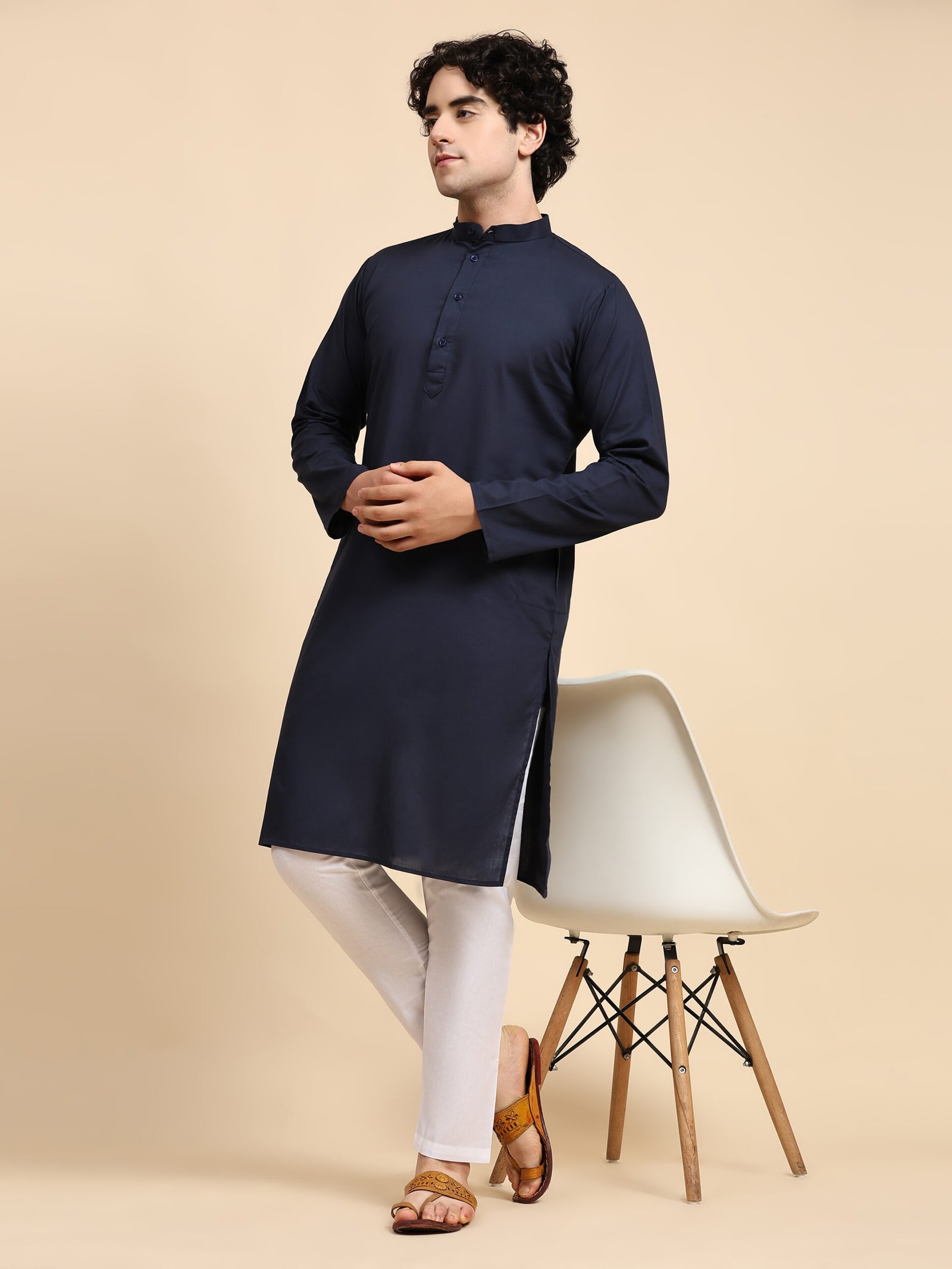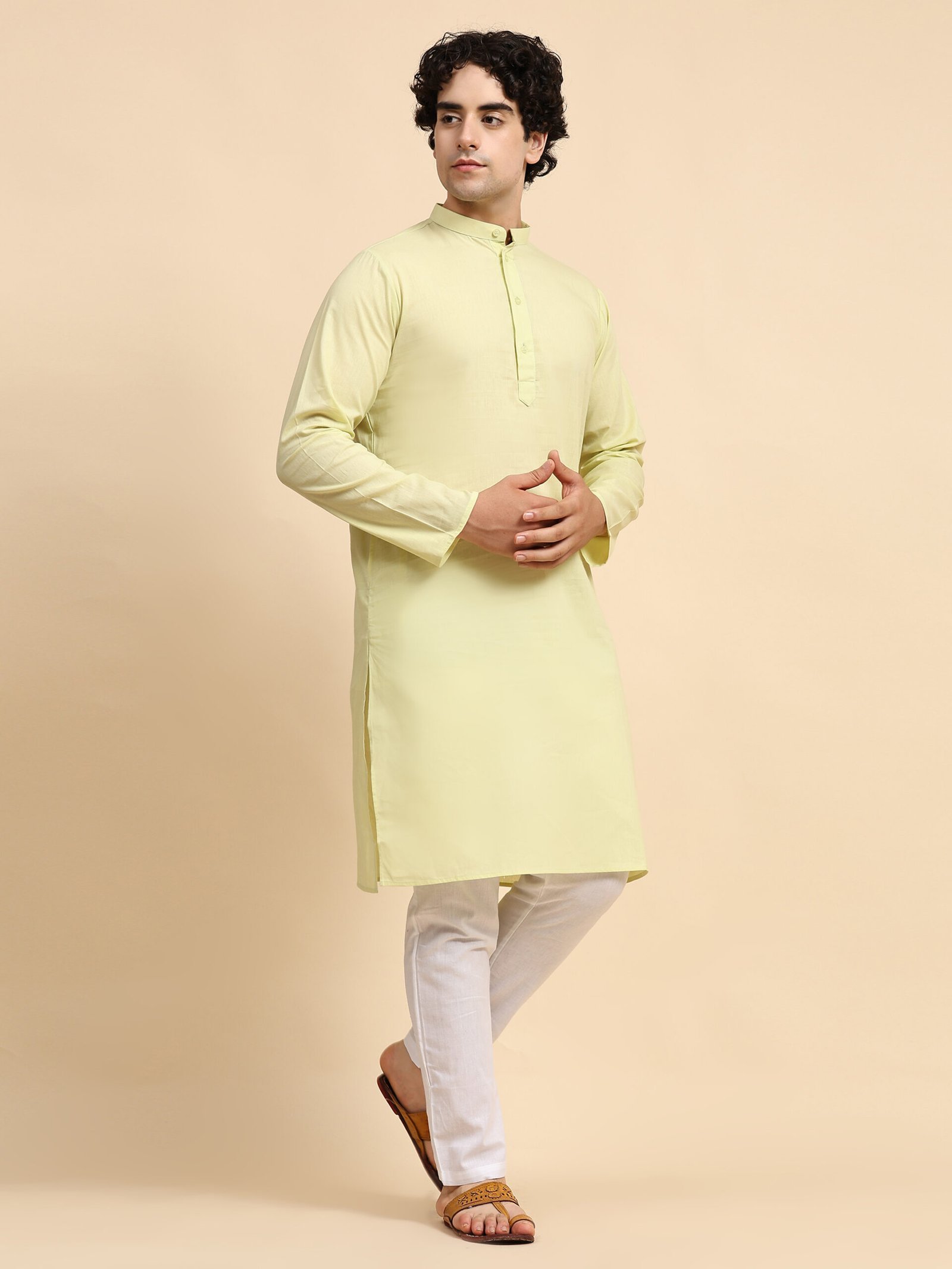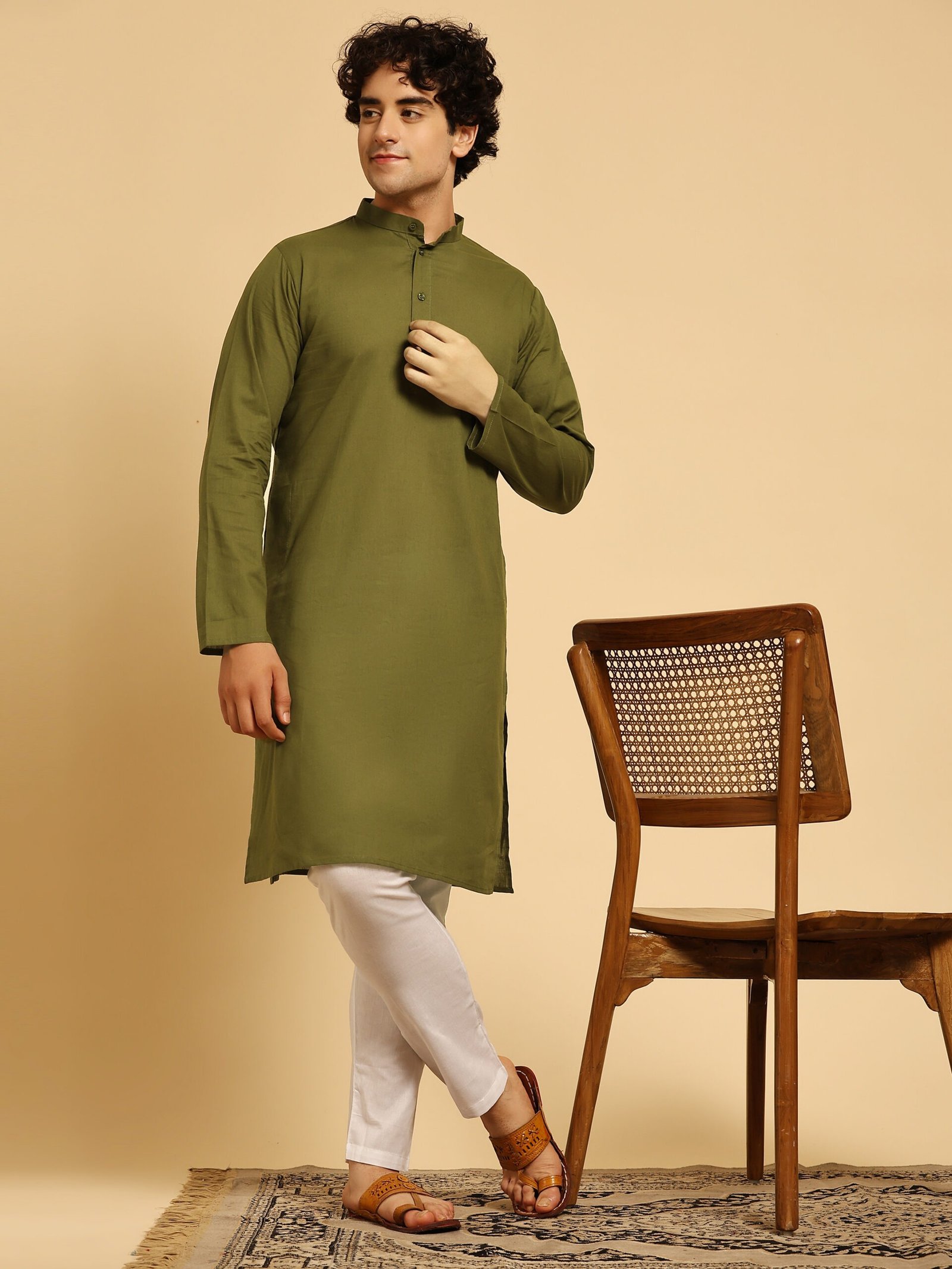South Asian women and men, especially in Bangladesh, India, Pakistan, and Nepal, use kurtas as traditional Kurta for Eid. It is a loose-fitting, tunic-like shirt that can vary in length, reaching anywhere from the waist to below the knees. Kurtas can be made from various fabrics such as cotton, silk, linen, or synthetic materials.
Typically, a kurta for men has long sleeves, although short-sleeved and sleeveless variations are also common. It usually features a straight cut, although some styles may have a flared silhouette. The neckline of a kurta can vary widely, from simple round or V-neck styles to more elaborate designs with collars or mandarin collars.
Kurtas come in a wide range of designs, colors, and patterns, ranging from simple and casual to intricately embroidered and embellished for formal occasions. They are worn with different types of bottoms, such as pajamas, churidars (tight-fitting trousers), salwars (loose-fitting trousers), or even jeans.
Kurtas are popular attire for various occasions, including festivals, weddings, religious ceremonies, casual outings, and everyday wear. They are prized for their comfort, versatility, and cultural significance, embodying the rich heritage and traditions of South Asian clothing.
Muslims around the world celebrate Eid, a joyous celebration that signals the end of Ramadan, the holy month of fasting. It’s a time for prayer, reflection, and gathering with loved ones. One of the most cherished aspects of Eid celebrations is dressing up in traditional attire that reflects the cultural richness and spiritual significance of the occasion. Among the myriad choices of attire, the kurta stands out as a timeless symbol of elegance and grace. In this article, we delve into the allure of kurtas for Eid, exploring their history, significance, and the diverse styles available for this auspicious occasion.

The Significance of Eid and Traditional Attire
For Muslims worldwide, Eid has great cultural and religious significance. It’s a time of spiritual renewal, forgiveness, and charity. As families come together to celebrate, dressing in traditional attire becomes an integral part of the festivities. Traditional attire not only reflects cultural heritage but also symbolizes modesty and respect for the occasion.
The History and Evolution of Kurtas
The kurta pajama has a rich history rooted in South Asian culture. Its origins can be traced back centuries, evolving from ancient forms of clothing worn in the Indian subcontinent. Initially, kurtas were simple garments made from cotton or silk, adorned with minimal embellishments. Over time, they underwent various transformations, influenced by Mughal, Persian, and British colonial styles. Today, Kurtas are available in a wide range of patterns, hues, and materials to suit a variety of tastes and styles.
Eid Kurta Styles: Traditional and Contemporary

On Eid, the kurta reigns supreme as the attire of choice for men seeking both elegance and comfort. Traditional Eid kurtas often feature intricate embroidery, delicate handiwork, and rich fabrics like silk or brocade. These kurtas exude a regal charm, perfect for formal gatherings and religious ceremonies.
For those favoring a more contemporary look, modern Eid kurtas offer a fusion of traditional craftsmanship with contemporary cuts and designs. These kurtas may feature sleek silhouettes, asymmetrical hems, or subtle embellishments, catering to the preferences of the younger generation while preserving the essence of tradition.
Choosing the Perfect Eid Kurta
Selecting the perfect Eid kurta involves considering various factors, including fabric, color, and embellishments. For daytime festivities, lightweight fabrics like cotton or linen offer comfort and breathability, while silk or brocade kurtas add a touch of luxury to evening celebrations. When it comes to colors, traditional hues like white, ivory, and pastels are popular choices symbolizing purity and serenity. However, vibrant shades like royal blue, emerald green, and deep maroon also make a statement, reflecting the festive spirit of Eid.
Accessorizing Your Eid Kurta
The proper accessories complete no Eid ensemble.. For men, pairing the kurta with classic accessories like a matching waistcoat, embroidered shawl, or intricately patterned turban adds a touch of refinement and elegance. Traditional footwear such as mojaris or khussas complement the kurta perfectly, completing the ensemble with style and grace.
Celebrating Eid with Kurta Pajama Sets
Kurta pajama sets are a popular choice for Eid celebrations, offering both style and comfort. These sets typically consist of a long kurta paired with matching pajama bottoms. Whether adorned with elaborate embroidery or simple yet elegant designs, kurta pajama sets provide a versatile and hassle-free option for Eid festivities.
Why Kurtas for Eid are Important on Eid
Eid holds profound significance in the Islamic calendar, marking the culmination of Ramadan, a month of fasting, prayer, and spiritual reflection. As Muslims come together to celebrate this joyous occasion, the choice of attire becomes an essential aspect of the festivities. Among the array of traditional garments, the kurta stands out as a symbol of cultural heritage, elegance, and reverence for the occasion. Here’s why kurtas for Eid are deemed important:
Cultural Identity:
Kurtas hold a significant place in the cultural heritage of South Asia and the broader Islamic world. Wearing a kurta for Eid not only reflects one’s religious identity but also serves as a proud assertion of cultural roots and traditions. It’s a way to honor the rich history and customs that have been passed down through generations.
Symbol of Modesty:
Modesty is an essential virtue in Islam, and the kurta epitomizes this principle with its loose-fitting silhouette and dignified appearance. By donning a kurta for Eid, individuals adhere to the values of modesty and humility, which are central to the spirit of the occasion.
Spiritual Significance:
Eid is a time of spiritual renewal, forgiveness, and gratitude for Muslims worldwide. The act of dressing in clean, presentable attire, such as a kurta, is considered a form of worship and a reflection of one’s inner state. It symbolizes reverence for the sacredness of the occasion and the blessings bestowed by Allah.
Festive Atmosphere:
Eid is a time of joy, celebration, and communal gatherings. Wearing traditional attire like a kurta adds to the festive atmosphere, creating a sense of unity and solidarity among individuals from diverse backgrounds. It fosters a feeling of belonging and camaraderie, reinforcing the bonds of family and community.
Expressing Gratitude:
Eid is an occasion to express gratitude for the blessings of Allah, including the gift of clothing and adornment. Wearing a well-crafted kurta for Eid is a way to show appreciation for the blessings of provision and sustenance, acknowledging the beauty and abundance in the world around us.
Preserving Heritage:
The tradition of wearing kurtas for Eid has been upheld for generations, passed down from ancestors who valued and cherished their cultural heritage. By continuing this practice, individuals contribute to the preservation and promotion of their cultural identity, ensuring that age-old traditions endure for future generations to embrace.
In essence, wearing a kurta for Eid is more than just a sartorial choice; it’s a testament to faith, culture, and community. It embodies the values of modesty, reverence, and gratitude while fostering a sense of belonging and celebration among Muslims worldwide. As such, kurtas hold a special significance during Eid, serving as a timeless symbol of tradition, elegance, and spiritual devotion.
Conclusion
As Muslims around the world prepare to celebrate Eid, the kurta remains a timeless symbol of tradition, elegance, and cultural heritage. Whether opting for a classic embroidered kurta or a contemporary designer ensemble, wearing a kurta for Eid is a celebration of faith, culture, and unity. With its rich history, diverse styles, and timeless appeal, the kurta continues to hold a special place in the hearts of millions, embodying the spirit of Eid with grace and sophistication.


